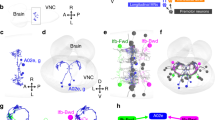Summary
-
1.
During wind-evoked turning in the cockroach the mesothoracic (T2) legs tend to move in antiphase with the ipsilateral metathoracic (T3) legs, although this relationship is not absolute.
-
2.
Intracellular stimulation of giant interneurons coupled with extracellular records from leg nerves 6Br4 and 5r1 indicate some substantial differences between the responses in T2 and those in T3.
-
3.
In T2 there is a predominance of depressor outputs for all dGIs, whereas, in T3 the biases between dGIs are more balanced. Thus, taking the responses of all dGIs into consideration, levator and depressor motor neurons should be equally excited in T3 but not in T2.
-
4.
Also, in T2 there is more variability in the responses than in T3. Although most motor responses in T2 involve initial depressor activity, some cases were found for each dGI in which levator activity consistently preceded depressor activation and some cases where both sets of motor neurons responded essentially at the same time.
-
5.
These data suggest that, in response to GI activity, more factors may be involved in determining the direction of leg movement in T2 than in T3.
Similar content being viewed by others
References
Callec JJ, Sattelle DB (1973) A simple technique for monitoring the synaptic actions of pharmacological agents. J Exp Biol 59:725–738
Callec JJ, Guillet JC, Pichon Y, Boistel J (1971) Further studies on synaptic transmission in insects. II. Relations between sensory information and its synaptic integration at the level of a single giant axon in the cockroach. J Exp Biol 55:123–149
Camhi JM, Nolen TG (1981) Properties of the escape system of cockroaches during walking. J Comp Physiol 142:339–346
Camhi JM, Tom W (1978) The escape behavior of the cockroachPeriplaneta americana. I. Turning response to wind puffs. J Comp Physiol 128:193–201
Camhi JM, Tom W, Volman S (1978) The escape behavior of the cockroachPeriplaneta americana. II. Detection of natural predators by air displacement. J Comp Physiol 128:203–212
Dagan D, Camhi JM (1979) Responses to wind recorded from the cercal nerve of the cockroachPeriplaneta americana. II. Directional selectivity of the sensory neurons innervating single columns of filiform hairs. J Comp Physiol 133:103–110
Daley DL (1982) Neural basis of wind-receptive fields of cockroach giant interneurons. Brain Res 238:211–216
Daley DL, Vardi N, Appignani B, Camhi JM (1981) Morphology of the giant interneurons and cereal nerve projections of the American cockroach. J Comp Neurol 196:41–52
Delcomyn F (1971) The locomotion of the cockroachPeriplaneta americana. J Exp Biol 54:443–452
Delcomyn F (1983) Activity and structure of movement-signalling (corollary discharge) interneurons in a cockroach. J Comp Physiol 150:185–193
Farley RD, Milburn NS (1969) Structure and function of the giant fibre system in the cockroach,Periplaneta americana. J Insect Physiol 15:457–476
Harrow ID, Hue B, Pelhate M, Sattelle DB (1980) Cockroach GIs stained by cobalt-backfilling of dissected axons. J Exp Biol 84:341–343
Hughes GM (1952) Walking movements of insects. J Exp Biol 29:267–284
Nicklaus R (1965) Die Erregung einzelner Fadenhaare vonPeriplaneta americana in Abhängigkeit von der Grösse und Richtung der Auslenkung. Z Vergl Physiol 50:331–362
Ogden TE, Citron MC, Pierantoni R (1978) The jet stream microbeveler: An inexpensive way to bevel ultrafine glass micropipettes. Science 201:469–470
Pearson KG (1972) Central programming and reflex control of walking in the cockroach. J Exp Biol 56:173–193
Pearson KG, Bergman SG (1969) Common inhibitory motoneurons in insects. J Exp Biol 50:445–473
Pearson KG, Iles JF (1970) Discharge patterns of coxal levator and depressor motoneurons of the cockroach,Periplaneta americana. J Exp Biol 52:139–165
Pearson KG, Stein RB, Malhorta SK (1970) Properties of action potentials from insect motor nerve fibers. J Exp Biol 53:299–316
Pearson KG, Reye DN, Robertson RM (1983) Phase-dependent influences of wing stretch receptors on flight rhythm in the locust. J Neurophysiol 49:1168–1181
Plummer MR, Camhi JM (1981) Discrimination of sensory signals from noise in the escape system of the cockroach: the role of wind acceleration. J Comp Physiol 142:347–357
Ritzmann RE (1981) Motor responses to paired stimulation of giant interneurons in the cockroachPeriplaneta americana. II. The ventral giant interneurons. J Comp Physiol 143:71–80
Ritzmann RE, Camhi JM (1978) Excitation of leg motor neurons by giant interneurons in the cockroachPeriplaneta americana. J Comp Physiol 125:305–316
Ritzmann RE, Pollack AJ (1981) Motor responses to paired stimulation of giant interneurons in the cockroachPeriplaneta americana. I. The dorsal giant interneurons. J Comp Physiol 143:61–70
Roeder K (1967) Nerve cells and insect behavior. Harvard University Press, Cambridge, Massachussetts
Stewart WW (1978) Functional connections between cells as revealed by dye-coupling with a highly fluorescent naphthalimide tracer. Cell 14:741–759
Tobias ML, Ritzmann RE (1982) Motor response of the cockroach mesothoracic ganglion to giant interneuron stimulation. Soc Neurosci Abstr 8:737
Westin J (1979) Responses to wind recorded from the cereal nerve of the cockroachPeriplaneta americana. I. Response properties of single sensory neurons. J Comp Physiol 133:97–102
Westin J, Langberg JL, Camhi JM (1977) Responses of giant interneurons of the cockroachPeriplaneta americana to wind puffs of different directions and velocities. J Comp Physiol 121:307–324
Author information
Authors and Affiliations
Additional information
A preliminary account of this work has been published (Tobias and Ritzmann 1982)
Rights and permissions
About this article
Cite this article
Tobias, M.L., Ritzmann, R.E. Responses of mesothoracic motor neurons to giant interneuron stimulation in the cockroach. J. Comp. Physiol. 154, 633–640 (1984). https://doi.org/10.1007/BF01350216
Accepted:
Issue Date:
DOI: https://doi.org/10.1007/BF01350216




